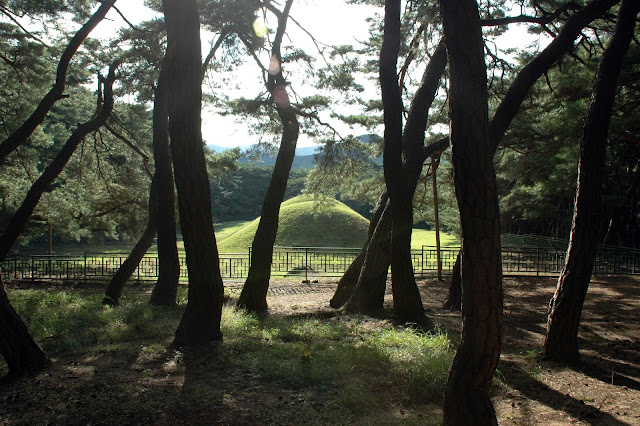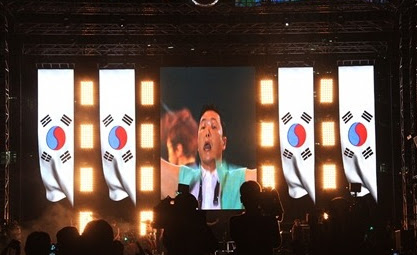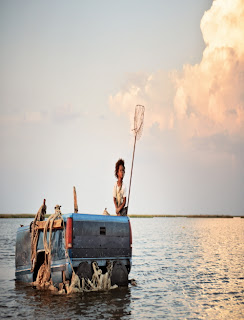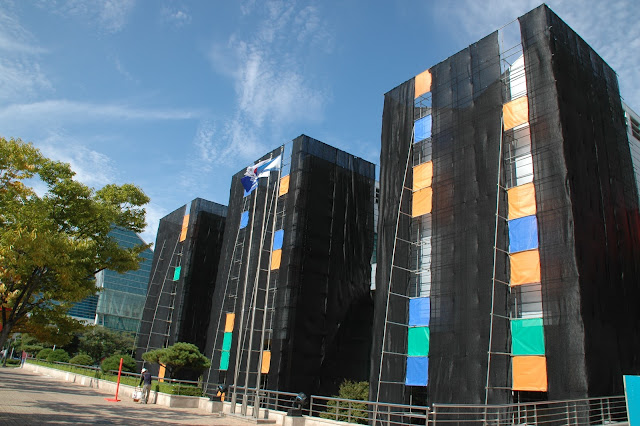Picturesque fireworks set backdrop for lasting memories
The eighth Busan Fireworks Festival takes place at Gwangalli Beach and Busan Asiad Main Stadium from Oct. 26 to 27. This year, the theme is love. The goal is to make Gwangalli Beach in front of Gwangan Bridge, the main stage of the fireworks festival, a world-famous proposal spot.
October 27 - Fireworks concert
From 6 p.m. to 8 p.m., there will be a fireworks concert at the Gwangalli Beach special stage. The police band’s drum group, a vocal ensemble, a Brazilian percussion performance and citizen cheering are scheduled, counting down the start of the fireworks show. The event is expected to be very exciting for all attendees and will hopefully create exciting memories that will last long into the future.
October 27- Busan Multi Fireworks Show
The Multi Fireworks Show, which is the highlight of the festival, takes place from 8 p.m. for 50 minutes. Roughly 1.5 billion won ($1.35 million) worth of fireworks, including 80,000 small and large pieces, will create a fancy spectacle under the theme of love. In terms of scale, it is nearly the same as the Harbor Bridge Fireworks Festival in Australia held every Dec. 31, the Fourth of July Fireworks Festival in United States celebrating Independence Day, Japan’s Omagari Fireworks Festival in August and the Canada Fireworks Contest.
Fireworks will shoot off from eight barges and also from Gwangan Bridge. This year, rainbow fireworks will be introduced for the first time in Korea. Colored half-moon-shaped rainbow fireworks will light up the center of Gwangalli Beach for one full minute. This type of firework was first presented in Dubai in 2010.
The world-class fireworks on display will include the classic one-kilometer Niagara, fireworks falling down like a waterfall from Gwangan Bridge, one of the highlights of the Busan Fireworks Festival. This year, the Niagara will be presented for one minute in two colors.
In between the fireworks show, there will be “proposal time” for one or two minutes. It is being introduced for the first time this year. During this time, sweet music with thousands of hearts, flowers and stars will add romance to the mood. The citizen of this year, students and neglected neighbors will press the button to start the fireworks show.
□Busan Fireworks Festival event schedule
Date Time Event Venue
Oct. 26 7-10 p.m. K-pop concert busan Asiad Main Stadium
Oct. 27 3-6 p.m. Street parade Gwangalli Beach road
6-8 p.m. Fireworks concert Gwangalli Beach special stage
8-9 p.m. Busan Multi Fireworks Show Gwangalli Beach
Best spots from which to admire the fireworks
The fancy fireworks festival is taking place again this year. So where is the best place to see the Busan Fireworks Festival?
1. Gwangalli Beach
The best place to see the fireworks is, of course, Gwangalli Beach. To secure a spot at the center of the beach, you need to bring lunch and come early. If you arrive two or three hours before the show, you might be able to find a spot at the corner of the beach, but if any later, it will be hard to find a place here. From Metro line no.2’s Gwangan Station, walk five minutes.
2. Millak Waterfront Park and Samik Apartment
The second recommended place is Millak Waterfront Park and the road next to Samik Apartment. Although it is not as good as the shore, you can see the fireworks up close. But you will be seeing the show from the side. From Metro line no.2’s Geumnyeonsan Station, take bus no. 108.
3. Mt. Geumnyeon
Mt. Geumnyeon is most popular following the Gwangalli shore. It is where you can see Gwangan Bridge and the beach at a glance. It is also preferred by photographers since they can catch a great angle. From Metro line no.2’s Geumnyeonsan Station, walk 20 to 30 minutes.
Warm clothes are a must when watching the fireworks festival
Participants should prepare warm clothes, snacks, and a camera or camcorder.
1. Warm clothes
While waiting for the festival to start and until the festival ends, you will need a thick, hooded shirt, comfortable pants and sneakers to endure the cold weather of late fall.
2. Simple snacks
The venue is cold, and it is hard to find something to eat there. Bring hot water or coffee in a thermos, and also bring along gimbap or pizza- something simple to eat when you get hungry.
3. Digital camera and camcorder
To take pictures of the moving fireworks in the dark night, use a digital camera or a camcorder with a tripod instead of a smartphone.
Tips ;How to get to the festival venue
1. By train (get off Busan Station)
*Bus: Take bus no. 40, 41, 42, 139, 1001, 1003; get off at the entrance of Gwangalli.
*Metro: Transfer to metro line no. 2 at Seomyeon Station → Get off at Geumnyeonsan or Gwangan stations.
2. By airplane (from Gimhae Int’l Airport)
*Limousine bus: Board toward Haeundae (15 minute interval) → Get off Namcheon-dong. (in front of Hwamok Mansion)
3. By intercity bus (from East Busan Terminal / Nopo-dong)
*Board metro and transfer to line no. 2 at Seomyeon Station → Get off at Geumnyeonsan or Gwangan stations.
*City bus : Take bus no. 49-1
4. By intercity bus (get off at Busan West Bus Terminal / Sasang District)
*Board metro → Get off at Geumnyeonsan Station (exit no. 3 or 5) or Gwangan Station. (exit no. 3 or 5)
*City bus : Take bus no. 62
5. City Bus
*Take bus no. 40, 41, 42, 139, 1001, 1003, 131, 131-1.
6. Metro
*Get off at Geumnyeonsan Station (exit no. 3 or 5) or Gwangan Station (exit no. 3 or 5) → Walk for 10 minutes.
7. By car
*Namhae Highway: West Busan Tollgate → Dongseo high-level road → Mt.Hwangnyeong Tunnel ramp → Daenam Underpass → Gwangalli Beach road → Gwangalli Beach
*Kyeongbu Highway: Guseo IC → Dosi Expressway → Suyeong Riverside road → Gwangan Bridge → Gwangalli Beach


The eighth Busan Fireworks Festival takes place at Gwangalli Beach and Busan Asiad Main Stadium from Oct. 26 to 27. This year, the theme is love. The goal is to make Gwangalli Beach in front of Gwangan Bridge, the main stage of the fireworks festival, a world-famous proposal spot.
October 27 - Fireworks concert
From 6 p.m. to 8 p.m., there will be a fireworks concert at the Gwangalli Beach special stage. The police band’s drum group, a vocal ensemble, a Brazilian percussion performance and citizen cheering are scheduled, counting down the start of the fireworks show. The event is expected to be very exciting for all attendees and will hopefully create exciting memories that will last long into the future.
October 27- Busan Multi Fireworks Show
The Multi Fireworks Show, which is the highlight of the festival, takes place from 8 p.m. for 50 minutes. Roughly 1.5 billion won ($1.35 million) worth of fireworks, including 80,000 small and large pieces, will create a fancy spectacle under the theme of love. In terms of scale, it is nearly the same as the Harbor Bridge Fireworks Festival in Australia held every Dec. 31, the Fourth of July Fireworks Festival in United States celebrating Independence Day, Japan’s Omagari Fireworks Festival in August and the Canada Fireworks Contest.
Fireworks will shoot off from eight barges and also from Gwangan Bridge. This year, rainbow fireworks will be introduced for the first time in Korea. Colored half-moon-shaped rainbow fireworks will light up the center of Gwangalli Beach for one full minute. This type of firework was first presented in Dubai in 2010.
The world-class fireworks on display will include the classic one-kilometer Niagara, fireworks falling down like a waterfall from Gwangan Bridge, one of the highlights of the Busan Fireworks Festival. This year, the Niagara will be presented for one minute in two colors.
In between the fireworks show, there will be “proposal time” for one or two minutes. It is being introduced for the first time this year. During this time, sweet music with thousands of hearts, flowers and stars will add romance to the mood. The citizen of this year, students and neglected neighbors will press the button to start the fireworks show.
□Busan Fireworks Festival event schedule
Date Time Event Venue
Oct. 26 7-10 p.m. K-pop concert busan Asiad Main Stadium
Oct. 27 3-6 p.m. Street parade Gwangalli Beach road
6-8 p.m. Fireworks concert Gwangalli Beach special stage
8-9 p.m. Busan Multi Fireworks Show Gwangalli Beach
Best spots from which to admire the fireworks
The fancy fireworks festival is taking place again this year. So where is the best place to see the Busan Fireworks Festival?
1. Gwangalli Beach
The best place to see the fireworks is, of course, Gwangalli Beach. To secure a spot at the center of the beach, you need to bring lunch and come early. If you arrive two or three hours before the show, you might be able to find a spot at the corner of the beach, but if any later, it will be hard to find a place here. From Metro line no.2’s Gwangan Station, walk five minutes.
2. Millak Waterfront Park and Samik Apartment
The second recommended place is Millak Waterfront Park and the road next to Samik Apartment. Although it is not as good as the shore, you can see the fireworks up close. But you will be seeing the show from the side. From Metro line no.2’s Geumnyeonsan Station, take bus no. 108.
3. Mt. Geumnyeon
Mt. Geumnyeon is most popular following the Gwangalli shore. It is where you can see Gwangan Bridge and the beach at a glance. It is also preferred by photographers since they can catch a great angle. From Metro line no.2’s Geumnyeonsan Station, walk 20 to 30 minutes.
Warm clothes are a must when watching the fireworks festival
Participants should prepare warm clothes, snacks, and a camera or camcorder.
1. Warm clothes
While waiting for the festival to start and until the festival ends, you will need a thick, hooded shirt, comfortable pants and sneakers to endure the cold weather of late fall.
2. Simple snacks
The venue is cold, and it is hard to find something to eat there. Bring hot water or coffee in a thermos, and also bring along gimbap or pizza- something simple to eat when you get hungry.
3. Digital camera and camcorder
To take pictures of the moving fireworks in the dark night, use a digital camera or a camcorder with a tripod instead of a smartphone.
Tips ;How to get to the festival venue
1. By train (get off Busan Station)
*Bus: Take bus no. 40, 41, 42, 139, 1001, 1003; get off at the entrance of Gwangalli.
*Metro: Transfer to metro line no. 2 at Seomyeon Station → Get off at Geumnyeonsan or Gwangan stations.
2. By airplane (from Gimhae Int’l Airport)
*Limousine bus: Board toward Haeundae (15 minute interval) → Get off Namcheon-dong. (in front of Hwamok Mansion)
3. By intercity bus (from East Busan Terminal / Nopo-dong)
*Board metro and transfer to line no. 2 at Seomyeon Station → Get off at Geumnyeonsan or Gwangan stations.
*City bus : Take bus no. 49-1
4. By intercity bus (get off at Busan West Bus Terminal / Sasang District)
*Board metro → Get off at Geumnyeonsan Station (exit no. 3 or 5) or Gwangan Station. (exit no. 3 or 5)
*City bus : Take bus no. 62
5. City Bus
*Take bus no. 40, 41, 42, 139, 1001, 1003, 131, 131-1.
6. Metro
*Get off at Geumnyeonsan Station (exit no. 3 or 5) or Gwangan Station (exit no. 3 or 5) → Walk for 10 minutes.
7. By car
*Namhae Highway: West Busan Tollgate → Dongseo high-level road → Mt.Hwangnyeong Tunnel ramp → Daenam Underpass → Gwangalli Beach road → Gwangalli Beach
*Kyeongbu Highway: Guseo IC → Dosi Expressway → Suyeong Riverside road → Gwangan Bridge → Gwangalli Beach

























-0.jpg)
.jpg)















.jpg)








